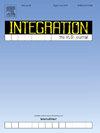A wide-input-range boost converter with three-phase self-start and adaptive zero current detector for photovoltaic energy harvesting
IF 2.5
3区 工程技术
Q3 COMPUTER SCIENCE, HARDWARE & ARCHITECTURE
引用次数: 0
Abstract
In this paper, a 0.1–4.2V input boost converter with 1.5 μA quiescent current consumption for microscale photovoltaic energy harvesting applications is proposed. The chip integrates a charge-pump-based three-phase self-start circuit that actives the converter with an input voltage of 0.6V. Moreover, the proposed self-start circuit reduces the capacitance area of charge pump by 40 % and the energy loss by 60 % compared to traditional two-phase self-start circuit. After completing self-start, the converter is capable of harvesting energy from an input voltage as low as 100 mV and covering a wide output power range of 5μW-460mW. The on-time of the high-side switch adapts dynamically to the input and output voltages for zero-current switching by adopting an adaptive zero current detector. The proposed chip has been fabricated using 180 nm CMOS technology and occupies an active area of 0.58 mm2. According to the measured efficiency at different load current, a peak efficiency of 93.7 % is achieved.
一种具有三相自启动和自适应零电流检测器的宽输入范围升压变换器,用于光伏能量收集
本文提出了一种输入0.1 ~ 4.2 v、静态电流消耗1.5 μA的微尺度光伏能量收集用升压变换器。该芯片集成了一个基于电荷泵的三相自启动电路,该电路以0.6V的输入电压激活转换器。此外,与传统的两相自启动电路相比,所提出的自启动电路将电荷泵的电容面积减少了40%,能量损失减少了60%。在完成自启动后,该变换器能够从低至100 mV的输入电压中收集能量,并覆盖5μW-460mW的宽输出功率范围。高侧开关的导通时间采用自适应零电流检测器,动态适应零电流开关的输入输出电压。该芯片采用180nm CMOS技术制造,有效面积为0.58 mm2。根据在不同负载电流下的效率实测,其峰值效率可达93.7%。
本文章由计算机程序翻译,如有差异,请以英文原文为准。
求助全文
约1分钟内获得全文
求助全文
来源期刊

Integration-The Vlsi Journal
工程技术-工程:电子与电气
CiteScore
3.80
自引率
5.30%
发文量
107
审稿时长
6 months
期刊介绍:
Integration''s aim is to cover every aspect of the VLSI area, with an emphasis on cross-fertilization between various fields of science, and the design, verification, test and applications of integrated circuits and systems, as well as closely related topics in process and device technologies. Individual issues will feature peer-reviewed tutorials and articles as well as reviews of recent publications. The intended coverage of the journal can be assessed by examining the following (non-exclusive) list of topics:
Specification methods and languages; Analog/Digital Integrated Circuits and Systems; VLSI architectures; Algorithms, methods and tools for modeling, simulation, synthesis and verification of integrated circuits and systems of any complexity; Embedded systems; High-level synthesis for VLSI systems; Logic synthesis and finite automata; Testing, design-for-test and test generation algorithms; Physical design; Formal verification; Algorithms implemented in VLSI systems; Systems engineering; Heterogeneous systems.
 求助内容:
求助内容: 应助结果提醒方式:
应助结果提醒方式:


